عندما يتعلق الأمر بتشكيل وصب المعادن، فإن القليل من الماكينات متعددة الاستخدامات ولا غنى عنها مثل آلة تشكيل لفة. إذا كنت تعمل في مجال الإنشاءات أو التصنيع، أو حتى مجرد فضول حول الآلات الصناعية، فإن فهم دور وكفاءة ماكينات تشكيل اللفائف أمر حيوي. في هذا الدليل المتعمق، سنرشدك في هذا الدليل المتعمق إلى كل ما تحتاج إلى معرفته: بدءًا من ما تقوم به ماكينات التشكيل بالدلفنة، إلى الأنواع المختلفة، وعمليات تشغيلها، وحتى كيفية اختيار أفضل مورد.
سواء كنت تتصفح فقط من أجل المعرفة أو كنت مستعداً للاستثمار في هذا الجهاز، فإن هذه المقالة مصممة لتزويدك بكل المعلومات في مكان واحد. لذا، اربط حزام الأمان، ودعنا نبدأ - كما هو مقصود!
ما هي آلة تشكيل اللفة؟
أ آلة تشكيل لفة عبارة عن قطعة من المعدات المصممة لتشكيل الشرائح المعدنية المسطحة إلى مقاطع جانبية دقيقة. تتضمن هذه العملية، التي تسمى التشكيل بالدلفنة، تغذية المعدن من خلال سلسلة من البكرات المتتالية. تقوم كل مجموعة من البكرات بثني المعدن قليلاً حتى يتم الحصول على الشكل المقطعي المطلوب.
تتميز هذه الطريقة بكفاءة عالية، خاصة لإنتاج مقاطع معدنية طويلة بأحجام كبيرة. ويستخدم التشكيل بالدلفنة في المقام الأول لمواد مثل الصلب والألومنيوم والنحاسوتستخدم على نطاق واسع في صناعة البناء والتشييد لمنتجات مثل ألواح التسقيف, ألواح الحائطو إطارات الأبواب.
الميزات الرئيسية ل التشكيل بالدلفنة Maالصينيون
- عملية الثني المستمر
- مناسبة للملامح الطويلة
- يعمل مع المعادن مثل الفولاذ والألومنيوم والنحاس
- كفاءة إنتاج عالية
- الحد الأدنى من نفايات المواد
- قابلة للتخصيص لإنتاج أشكال وأحجام مختلفة
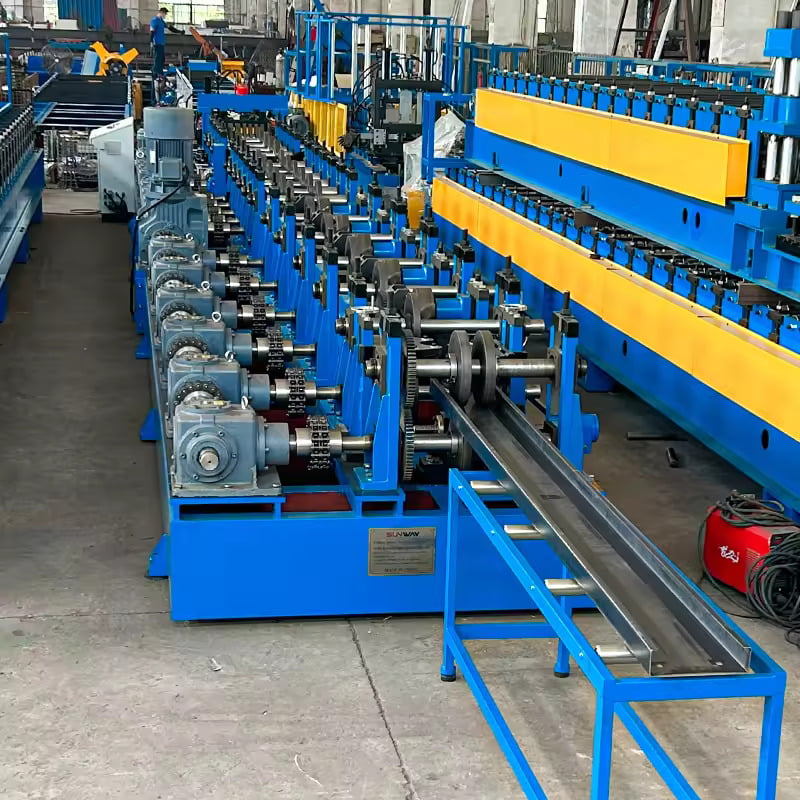
أنواع ماكينات التشكيل بالدلفنة: التخصيص حسب الاحتياجات المختلفة
آلات تشكيل اللف تأتي بأشكال وأحجام مختلفة، كل منها مصمم لتطبيقات محددة. هنا، سوف نتناول هنا الأشكال المحددة أنواع ماكينات التشكيل بالدلفنةمصنفة حسب الوظائف التي تخدمها.
| نوع الماكينة | الوصف |
|---|---|
| ماكينة أحادية الحامل | مجموعة واحدة من البكرات المستخدمة، مناسبة للأشكال البسيطة ذات أحجام الإنتاج المنخفضة. |
| ماكينة متعددة الحامل | يتكون من محطات أسطوانية متعددة لملامح أكثر تعقيداً ومخرجات أعلى. |
| التشكيل بالدلفنة المحمولة | الماكينات الصغيرة المتنقلة المستخدمة مباشرةً في مواقع الإنشاءات. |
| التشكيل بالدرفلة الدقيقة | ماكينات عالية الدقة تُستخدم للقطع التي تتطلب تفاوتات ضيقة. |
| التشكيل الآلي بالدرفلة | آلات مؤتمتة بالكامل مع الحد الأدنى من التدخل البشري، مما يعزز الإنتاجية. |
| التشكيل بالدلفنة عالية السرعة | مصممة لمعدلات إنتاج عالية، ومناسبة لبيئات الإنتاج الضخم. |
| التشكيل بالدلفنة الهيدروليكية | تستخدم القوة الهيدروليكية لثني المواد الأثقل والأكثر سمكاً. |
| ماكينة تعمل بمحرك مؤازر | مزوّدة بمحركات مؤازرة للتحكم أكثر دقة في عملية التشكيل. |
| ماكينة التشكيل بالدرفلة CNC | يتم التحكم فيها بواسطة الكمبيوتر، مما يسمح بأشكال وملامح قابلة للتخصيص بدرجة كبيرة. |
| التشكيل بالدلفنة حسب الطلب | مصممة خصيصًا لتلبية احتياجات العملاء، ومصممة خصيصًا لتناسب تصميمات المنتجات الفريدة. |
لكل نوع من الماكينات مزاياه وعيوبه، اعتمادًا على متطلبات خط الإنتاج الخاص بك. إن فهم النموذج الذي يناسب احتياجاتك يمكن أن يوفر لك الوقت والمال والصداع في المستقبل.
كيف تعمل ماكينة التشكيل بالدرفلة؟ العملية الكاملة
قد تتساءل، "كيف تعمل ماكينة التشكيل بالدرفلة بالضبط؟ إنها عملية رائعة، حيث تقوم بتحويل المعدن الخام إلى مقاطع جانبية دقيقة من خلال نظام آلي مستمر. فيما يلي، سنقوم بتفصيل العملية بأكملها عملية عمل ماكينة التشكيل بالدلفنة:
عملية التشكيل بالدرفلة خطوة بخطوة
- تحميل المواد: يتم تلقيم الشرائط أو الملفات المعدنية الخام في الماكينة. وتُستخدم مواد مثل الفولاذ أو الألومنيوم أو النحاس بشكل شائع.
- الاستقامة الأولية: تمر المادة من خلال جهاز تسوية يقوم بتسويتها قبل بدء التشكيل.
- المحطات الدوارة: يمر الشريط عبر محطات أسطوانية متعددة، حيث تقوم كل محطة بثني المعدن أكثر قليلاً حتى يتم الوصول إلى الشكل النهائي.
- التقطيع حسب الطول: بعد تشكيل المظهر الجانبي المطلوب، يتم قطع المادة حسب الطول باستخدام أدوات القطع - يمكن أن يكون ذلك باستخدام قاطع ميكانيكي أو ليزر.
- التجميع والتكديس: يتم جمع المنتجات النهائية وتكديسها لتكون جاهزة للشحن أو لمزيد من المعالجة.
تتسم هذه العملية السلسة بالكفاءة العالية وتقلل من الهدر، مما يجعلها مثالية للإنتاج بكميات كبيرة.
المكونات الرئيسية لماكينة التشكيل بالدرفلة ووظائفها
يلعب كل جزء من أجزاء ماكينة التشكيل بالدلفنة دورًا حاسمًا في ضمان تشغيلها بسلاسة وكفاءة. دعونا نلقي نظرة على المكونات الرئيسية ووظائفها.
| المكوّن | الوظيفة |
|---|---|
| البكرات | مسؤول عن تشكيل المعدن بالشكل المطلوب. |
| وحدة تغذية المواد | تغذية المعدن الخام في الماكينة بمعدل ثابت. |
| وحدة الاستقامة | يعمل على تسطيح المواد قبل دخولها إلى المحطات الدوارة. |
| وحدة القطع | تقطيع المعدن المُشكّل إلى الطول المطلوب بعد التشكيل. |
| محرك (كهربائي أو هيدروليكي) | تشغل البكرات والأجزاء الميكانيكية الأخرى للماكينة. |
| وحدة التحكم (CNC أو يدوي) | يتحكم في التشغيل ويضبط المعلمات مثل السرعة والقوة. |
| لفات الدليل | حافظ على محاذاة الشريط المعدني أثناء تحركه عبر الماكينة. |
| Uncoiler | يمسك الملف المعدني ويطلقه في الماكينة. |
| نظام التثقيب | تثقب الثقوب أو الشقوق في المادة أثناء عملية التشكيل. |
-
 آلة التشكيل بالدلفنة لكروم العنب
آلة التشكيل بالدلفنة لكروم العنب -
 آلة تشكيل لفة Sigma Purlin قابلة للتغيير ذات الحجم الأوتوماتيكي
آلة تشكيل لفة Sigma Purlin قابلة للتغيير ذات الحجم الأوتوماتيكي -
 آلة التشكيل بالدلفنة لإطار الخزانة الكهربائية
آلة التشكيل بالدلفنة لإطار الخزانة الكهربائية -
 آلة التشكيل بالدلفنة للسكك الحديدية Din
آلة التشكيل بالدلفنة للسكك الحديدية Din -
 آلة تشكيل سلم الكابلات
آلة تشكيل سلم الكابلات -
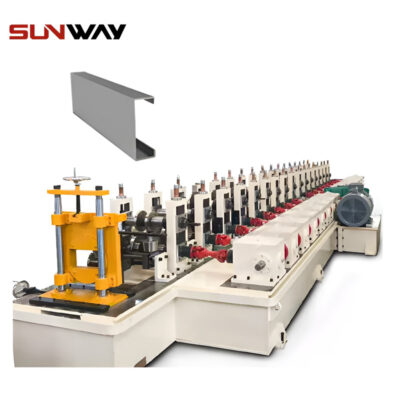 PV تصاعد قوس C آلة تشكيل الملف الشخصي
PV تصاعد قوس C آلة تشكيل الملف الشخصي -
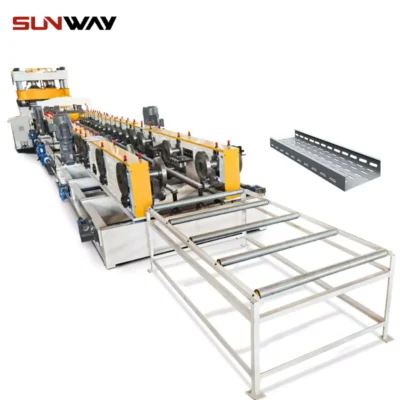 آلة تشكيل علبة الكابلات
آلة تشكيل علبة الكابلات -
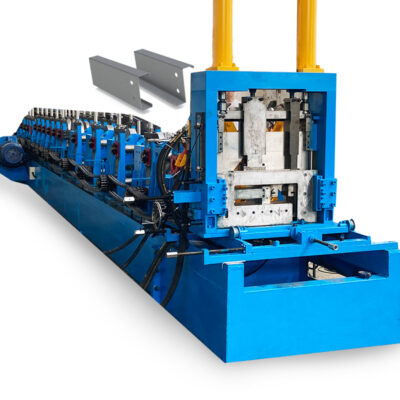 آلة التشكيل بالدلفنة على البارد لقناة CZ
آلة التشكيل بالدلفنة على البارد لقناة CZ -
 آلة التشكيل بالدلفنة لقوس تصاعد PV (ملف تعريف HAT / أوميغا)
آلة التشكيل بالدلفنة لقوس تصاعد PV (ملف تعريف HAT / أوميغا)
سرعة الماكينة وكفاءتها: ما يمكن توقعه من ماكينات التشكيل بالدرفلة
أحد العوامل الرئيسية التي يجب أخذها في الاعتبار عند شراء آلة تشكيل لفة هو سرعته وكفاءته. هذا أمر بالغ الأهمية بشكل خاص إذا كنت تعمل في بيئة إنتاجية عالية الحجم. لنلقِ نظرة على السرعات النموذجية وكيفية تأثيرها على الإنتاجية.
| نوع الماكينة | متوسط السرعة | الكفاءة |
|---|---|---|
| ماكينة أحادية الحامل | 5-10 أمتار في الدقيقة | كفاءة أقل، مناسبة لعمليات الإنتاج الصغيرة. |
| ماكينة متعددة الحامل | 20-30 متراً في الدقيقة | كفاءة عالية، الأفضل للمهام المعقدة وذات الحجم الكبير |
| التشكيل بالدلفنة عالية السرعة | 40-100 متر في الدقيقة | كفاءة عالية للغاية للإنتاج بكميات كبيرة. |
| التشكيل بالدرفلة الدقيقة | 10-15 متراً في الدقيقة | سرعات أبطأ ولكن بدقة عالية للغاية. |
| التشكيل بالدلفنة الهيدروليكية | 5-15 متر في الدقيقة | أبطأ ولكن مثالية للمواد الثقيلة. |
المعلمات الميكانيكية المخصصة لماكينات التشكيل بالدلفنة
يختلف كل خط إنتاج عن الآخر، ولهذا السبب غالبًا ما يكون التخصيص ضروريًا. يمكنك ضبط العديد من المعلمات الميكانيكية لتلبية احتياجات التصنيع المحددة.
| المعلمة | الوصف |
|---|---|
| سُمك المادة | يتراوح من 0.3 مم إلى 5 مم، حسب نوع المعدن. |
| عرض الملف الشخصي | يمكن أن تختلف بناءً على متطلبات العميل؛ وتتراوح عادةً بين 100 مم و800 مم |
| محطات التشكيل | يمكن تخصيص عدد المحطات بناءً على مدى تعقيد الملف الشخصي. |
| طول القطع | قابل للتعديل لإنتاج أحجام مختلفة من المنتجات، عادةً من 0.5 متر إلى 12 متر. |
| قدرات التثقيب | أنماط تثقيب قابلة للتخصيص للثقوب أو الفتحات أو الشقوق. |
| قوة المحرك | يمكن تعديلها بناءً على المواد وسرعة الإنتاج. |
| نوع وحدة التحكم | اختر بين أنظمة CNC أو اليدوية أو شبه الآلية. |
تطبيقات ماكينات التشكيل بالدلفنة: أين تُستخدم؟
ماكينات التشكيل بالدلفنة متعددة الاستخدامات ولها مجموعة واسعة من التطبيقات. فيما يلي قائمة بالصناعات والمنتجات التي يشيع فيها استخدام هذه الماكينات.
| طلب | الوصف |
|---|---|
| ألواح الأسقف والجدران | صفائح مموجة تستخدم في البناء للأسقف وكسوة الجدران. |
| إطارات الأبواب والنوافذ | تنتج إطارات للمباني السكنية والصناعية على حد سواء. |
| صناعة السيارات | إنشاء قطع معدنية لإطارات المركبات والعناصر الهيكلية. |
| أنابيب التدفئة والتهوية وتكييف الهواء | تستخدم في إنتاج أنابيب أنابيب التدفئة والتهوية وتكييف الهواء. |
| أثاث فولاذي | أشكال التشكيلات المعدنية المستخدمة في الأثاث المكتبي والصناعي. |
| الخزائن الكهربائية | تنتج حاويات للأنظمة الكهربائية وخزانات التحكم. |
| إطارات الألواح الشمسية | تشكل مقاطع معدنية لتركيب الألواح الشمسية على أسطح المنازل. |
| أنظمة التخزين | إنشاء أرفف ورفوف وحلول تخزين أخرى. |
| السياج والحواجز الواقية | تنتج حواجز وأسيجة السلامة للطرق السريعة والأماكن الصناعية. |
| صواني الكابلات | تشكيل المعادن في صواني تدعم الأسلاك الكهربائية. |
تركيب ماكينات التشكيل بالدرفلة وتشغيلها وصيانتها
يعد ضمان التركيب والتشغيل والصيانة المناسبة لماكينة التشكيل بالدلفنة أمرًا ضروريًا لتحقيق الكفاءة والأداء على المدى الطويل.
| العملية | تفاصيل |
|---|---|
| التركيب | يتطلب محاذاة مناسبة للماكينة، والتوصيلات الكهربائية، والإعداد الهيدروليكي. |
| العملية | يتطلب عادةً مشغلين مدربين يفهمون معدلات تغذية المواد وأدوات التحكم في الماكينة. |
| الصيانة | يعد التشحيم والتنظيف المنتظم واستبدال المكونات البالية أمرًا ضروريًا لطول العمر الافتراضي. |
| تدابير السلامة | تشمل التوقف في حالات الطوارئ، وحراس السلامة، وعمليات الفحص المنتظمة للماكينة. |
| استكشاف الأخطاء وإصلاحها | يمكن حل المشاكل مثل اختلال المواد أو تآكل الأسطوانة بالتدخل في الوقت المناسب. |
اختيار المورد المناسب: قرار رئيسي
عند الاستثمار في ماكينة التشكيل بالدرفلة، فإن اختيار المورد المناسب يمكن أن يحدث فرقًا كبيرًا. فيما يلي تفصيل لما يجب عليك مراعاته عند اختيار المورد.
| العامل | ما الذي تبحث عنه |
|---|---|
| نطاق السعر | قارن الأسعار من موردين مختلفين. يمكن أن تتراوح الماكينات من $50,000 إلى $200,000. |
| السمعة | ابحث عن مراجعات العملاء وسمعة الصناعة. |
| الدعم والضمان | ابحث عن الموردين الذين يقدمون ضمانات ممتدة ودعم جيد لما بعد البيع. |
| التخصيص | تأكد من قدرة المورد على تلبية احتياجات التخصيص الخاصة بك. |
| الموقع | اختر المورد الذي يمكنه توفير خدمات التوصيل والدعم في الوقت المناسب. |
الموردون ونطاق السعر
| المورد | نطاق السعر (بالدولار الأمريكي) | الموقع |
|---|---|---|
| ماكينات سامكو | $60,000 – $150,000 | كندا |
| جوبيتر للتشكيل بالدرفلة | $50,000 – $180,000 | الهند |
| يودر | $100,000 – $250,000 | الولايات المتحدة الأمريكية |
| تشكيل الدرفلة في هانغتشو | $45,000 – $120,000 | الصين |
| مجموعة Formtek | $80,000 – $200,000 | الولايات المتحدة الأمريكية |
إيجابيات وسلبيات ماكينات التشكيل بالدرفلة: المزايا والقيود
مثل أي معدات صناعية، فإن ماكينات التشكيل بالدرفلة لها نقاط قوتها وضعفها. دعونا نتعمق في مقارنة بين الإيجابيات والسلبيات.
المزايا
- كفاءة إنتاج عالية: بمجرد الإعداد، يمكن تشغيل الماكينة بشكل مستمر، مما ينتج كمية كبيرة من التشكيلات المعدنية بأقل وقت تعطل.
- تعدد الاستخدامات: يمكن استخدامها لمجموعة واسعة من المواد والملامح.
- الحد الأدنى من النفايات: تقلل عملية التشكيل بالدلفنة المستمرة من نفايات الخردة المعدنية، مما يجعلها فعالة من حيث التكلفة وصديقة للبيئة.
- الدقة: الماكينات عالية الدقة، وتنتج قطعًا ذات تفاوتات ضيقة.
- التخصيص: قابل للتخصيص بسهولة لإنتاج أشكال وأحجام مختلفة لمختلف الصناعات.
القيود
- استثمار أولي مرتفع: قد تكون التكلفة الأولية لشراء ماكينة التشكيل بالدلفنة وإعدادها كبيرة.
- المهارات المتخصصة المطلوبة: يحتاج المشغلون إلى تدريب مناسب للتعامل مع الماكينات بفعالية.
- يقتصر على عمليات الإنتاج الطويلة: التشكيل بالدلفنة هو الأنسب لعمليات الإنتاج الطويلة، مما يجعله أقل كفاءة للدفعات الصغيرة.
كيفية اختيار مورد ماكينات التشكيل بالدرفلة
يعد اختيار المورد المناسب أمرًا بالغ الأهمية عند الاستثمار في ماكينة التشكيل بالدرفلة. فيما يلي الاعتبارات الرئيسية:
العوامل التي يجب مراعاتها عند اختيار المورد
- السمعة: اختر دائمًا الموردين الذين لديهم سجل حافل في تقديم آلات عالية الجودة.
- التخصيص: تأكد من قدرة المورد على تلبية متطلباتك الدقيقة من حيث تصميم الماكينة والإنتاج.
- خدمات الدعم: دعم ما بعد البيع، بما في ذلك التركيب والصيانة والإصلاحات، أمر ضروري.
- السعر: على الرغم من أهمية السعر، إلا أنه لا ينبغي أن يكون العامل الحاسم الوحيد. ركز على القيمة التي يقدمها المورد.
- الضمانات: المورد الذي يقدم ضماناً جيداً يشير إلى الثقة في منتجه.
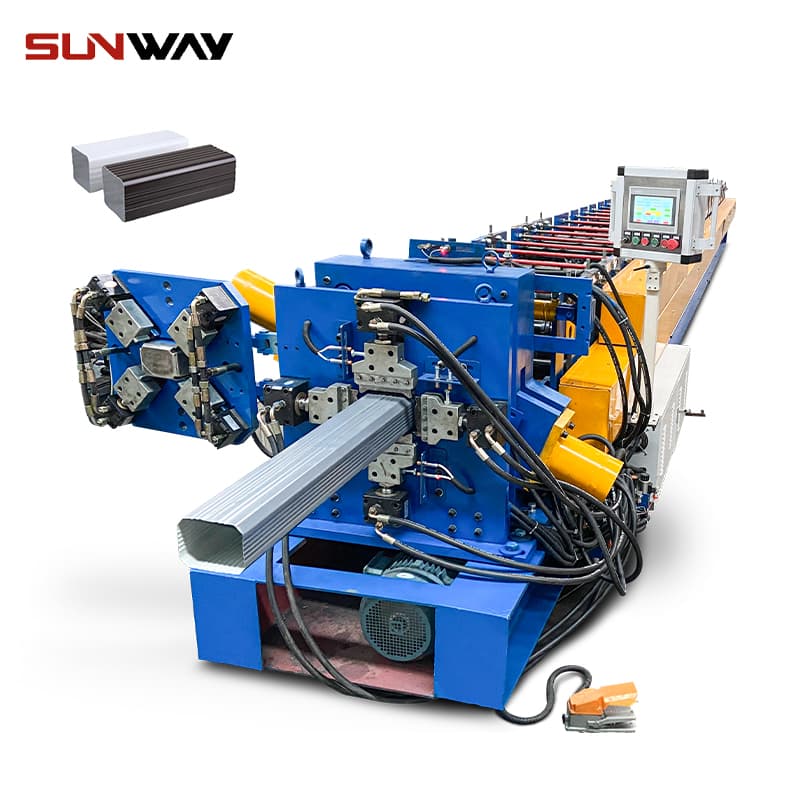
الأسئلة الشائعة
| سؤال | الإجابة |
|---|---|
| فيما تُستخدم ماكينة التشكيل بالدلفنة؟ | تُستخدم ماكينة التشكيل بالدلفنة لتشكيل الشرائح المعدنية المسطحة في التشكيلات الجانبية المرغوبة لأغراض البناء والأغراض الصناعية. |
| هل يمكن تخصيص التشكيل بالدرفلة؟ | نعم، يمكن تخصيص ماكينات التشكيل بالدلفنة لإنتاج مجموعة كبيرة من الأشكال والأحجام والتصميمات. |
| ما هي المواد التي يمكن استخدامها في التشكيل بالدرفلة؟ | يشيع استخدام معادن مثل الصلب والألومنيوم والنحاس والزنك في ماكينات التشكيل بالدلفنة. |
| ما مدى سرعة ماكينات التشكيل بالدرفلة؟ | يمكن أن تتراوح السرعات من 5 أمتار إلى 100 متر في الدقيقة، حسب نوع الماكينة والمواد. |
| كم تبلغ تكلفة ماكينات التشكيل بالدرفلة؟ | تتفاوت الأسعار على نطاق واسع، من $50,000 إلى أكثر من $200,000، وذلك حسب إمكانيات الماكينة. |
استنتاج
بحلول الآن، يجب أن يكون لديك فهم قوي لماهية آلة تشكيل لفة وكيف تعمل، وما إذا كانت مناسبة لاحتياجاتك الإنتاجية. سواء كنت تبحث عن إنتاج بكميات كبيرة أو ماكينات مخصصة معقدة، فهناك ماكينة مناسبة لك. المفتاح هو فهم متطلباتك المحددة ومطابقتها مع الماكينة والمورد المناسبين.
من خلال اتباع هذا الدليل، ستكون في طريقك لاتخاذ قرار مستنير يفيد عملك لسنوات قادمة.
الأسئلة الشائعة (FAQ)
1) ما هي التفاوتات التي يمكن أن تحققها ماكينة التشكيل بالدلفنة الحديثة؟
- مع الحوامل الدقيقة، والأدوات عالية الجودة، والتغذية المؤازرة، توقع ± 0.3-0.5 مم على الأبعاد الحرجة و± 0.5-1.0 مم على طول القطع بسرعات نموذجية. يمكن أن تصل الخطوط فائقة الدقة مع القياس المضمن إلى ± 0.2 مم على ارتفاع المظهر الجانبي.
2) كيف يمكنني الاختيار بين القواطع الهيدروليكية والميكانيكية والقواطع التي تعمل بالمؤازرة؟
- هيدروليكي: قوي للمقاييس السميكة وقوى القص العالية. ميكانيكية (كامة/دولاب هوائي): اقتصادية للمقاييس الرقيقة إلى المتوسطة. القطع الطائر المؤازر: الأفضل للسرعة العالية وتفاوتات الطول الضيقة مع الحد الأدنى من النتوءات.
3) هل يمكن لخط التشكيل بالدلفنة الواحد تشغيل ملفات تعريف متعددة؟
- نعم. تشمل الخيارات أدوات الكاسيت وقواعد الطوافة ومجموعات الزهور سريعة التغيير. يمكن أن تنخفض مدة التبديل من 3-6 ساعات إلى 30-60 دقيقة مع الكاسيتات المحاذاة مسبقًا والوصفات الرقمية.
4) ما هي مشكلات جودة الملف الأكثر تأثيرًا على الخردة؟
- موجة تاج الملف/حافة الملف، وتباين السُمك، والإجهاد المتبقي، وضعف تزييت السطح. قم بالتخفيف من هذه المشاكل باستخدام مواصفات التسطيح الواردة (I-unit/STM)، وتخطيط الملف، وتحسين المردود/مقوّم الاستقامة.
5) ما هي المعايير أو الشهادات المهمة للتصدير؟
- ISO 9001 (إدارة الجودة)، وISO 9001 (إدارة الجودة)، وEC/UKCA (سلامة الماكينات)، وIEC/UL/CSA (الكهربائية)، والمواصفات الخاصة بالمنتج مثل EN 1090 للمكونات الهيكلية أو AAMA/ASTM لمقاطع البناء. بالنسبة للسيارات، قد تكون هناك حاجة إلى PPAP وIATF 16949.
اتجاهات الصناعة 2025
- يقلل تحسين الإعداد الذي يعتمد على الذكاء الاصطناعي من الخردة في المرة الأولى بنسبة 20-35% باستخدام التوائم الرقمية لزهور البكرات.
- يتسارع اعتماد الفولاذ المطلي بالزنك-أل-ملغ (ZM120-ZM275) في التشكيلات الإنشائية بسبب عمر التآكل الذي يتراوح بين 2-4 أضعاف مقارنةً بـ G90.
- تقلل واجهات الإدارة العليا منخفضة التعليمات البرمجية والتبديل الموجه من وقت التدريب بنحو 30% ووقت التبديل بنحو 40-60%.
- تعمل المحركات الذكية للطاقة والمكونات الهيدروليكية المتجددة على خفض الكيلوواط/طن بمقدار 10-18%.
- أصبح قياس الرؤية المضمنة سائدًا في عمليات فحص الأبعاد 100%، مما يتيح مراقبة الأداء الفردي في الوقت الحقيقي وتعديلات الحامل التلقائية.
- مرونة سلسلة التوريد: المزيد من المشترين يطلبون التوريد المزدوج للأدوات والإلكترونيات المهمة، ويحددون اتفاقيات مستوى الخدمة المحلية.
لمحة عن السوق والتكنولوجيا (تقديرات 2013-2025)
| متري | 2023 | 2024 | 2025 (تقديري) | الملاحظات/المصادر |
|---|---|---|---|---|
| السوق العالمي للمنتجات المشكلة باللفائف (مليار دولار أمريكي) | 63.5 | 66.9 | 71.2 | توليف تقارير الصناعة: MarketsandMarkets, Grand View Research |
| متوسط سرعة الخط لملامح البناء (م/دقيقة) | 35 | 37 | 40 | كتالوجات البائعين، والإفصاحات الخاصة بالمعارض التجارية |
| المصانع التي تستخدم الصيانة التنبؤية (%) | 28% | 35% | 45% | توقعات ديلويت 2024-2025 للتصنيع 2024-2025 |
| حصة الزنك-أل-ملغ في لفائف البناء (%) | 20% | 26% | 33% | أرسيلور ميتال ماغنليس، نيبون ستيل ZAM الموجزات الفنية |
| كثافة الطاقة النموذجية (كيلوواط ساعة/طن مكون) | 110 | 104 | 96 | دراسات حالة مصنعي المعدات الأصلية؛ المعايير الداخلية |
| حصة الخطوط ذات الرؤية المضمنة/المسح الضوئي المدمجة (%) | 18% | 25% | 38% | بيانات العارضين في معرض EMO/EuroBLECH |
المراجع الرئيسية:
- EN 10169، EN 10346 للفولاذ المطلي؛ AISI/COS لإرشادات التشكيل بالدلفنة
- توقعات ديلويت العالمية للتصنيع 2025
- البيانات الفنية لشركة أرسيلورميتال ماغنيليس أرسيلور ميتال ماغنيليس، نيبون ستيل ZAM
- ISO 14644 (نظافة تجميع إلكترونيات السيارات)؛ معايير IEC/UL للوحات التحكم
أحدث الحالات البحثية
دراسة الحالة 1: التوأم الرقمي بمساعدة التوأم الرقمي يقطع الخردة (2024)
- الخلفية: قامت إحدى الشركات الأوروبية المصنعة لمنتجات البناء بتشغيل لفائف مطلية مسبقًا من 0.5-0.8 مم على ماكينة تشكيل بالدلفنة متعددة القوائم مع تغييرات متكررة في العرض/الملف الشخصي مما تسبب في 4.21 تيرابايت 3 طن متري في المتوسط لبدء التشغيل.
- الحل: تم تنفيذ توأم رقمي قائم على الفيزياء لزهرة التدحرج (نموذج زنبركي قائم على FE) مرتبط بوصفات PLC؛ وإضافة وضع حامل مؤازر وقياس الكاميرا المضمنة لإجراء تعديلات الحلقة المغلقة.
- النتائج: انخفضت الخردة عند بدء التشغيل إلى 2.31 طن متري (-451 طن متري)، وانخفض متوسط وقت التغيير إلى 52 دقيقة، و+7.8 نقاط +7.8 نقاط. المصادر: مطبوعات حالة Altair Inspire/Form؛ أوراق بيضاء لمصنعي المعدات الأصلية حول التشكيل في حلقة مغلقة.
دراسة الحالة 2: تحويل الزنك-أل-ملغ للأسقف الساحلية (2025)
- الخلفية: احتاج مُصنِّع APAC إلى عمر أطول للتآكل دون زيادة السُمك أو التكلفة لكل متر للمشاريع الساحلية.
- الحل: التحويل من G90 إلى ZM250؛ ترقية سطح الأدوات (TiN) ومواد التشحيم لتقليل الالتقاط؛ إعادة معايرة الحوامل للتحكم في تكسير الحواف؛ إضافة بروتوكول ضمان الجودة برش الملح.
- النتائج: المصادر: أوراق بيانات ArcelorMittal Magnelis؛ تقارير ضمان جودة المشروع.
آراء الخبراء
- الدكتورة هانا فوغت، رئيسة قسم هندسة العمليات، مجموعة فورمتيك
- وجهة نظر: "ما يميز 2025 هو التحكم في الحلقة المغلقة. فالخطوط التي تقرن الرؤية المضمنة مع وضع الحامل المؤازر تحافظ على Cp/Cpk>1.33 في حالات الخفوت الحرجة حتى أثناء تغيير مجموعة الملفات".
- خورخي ألميدا، مدير العمليات، ماكينات سامكو
- وجهة نظر: "تعمل أشرطة التغيير السريع والأطواف الموحدة على تحويل الطلب متعدد الأشكال من عنق الزجاجة إلى مركز ربح. استهدفوا إجراء عمليات تبديل أقل من 60 دقيقة لحماية معدل التشغيل اليومي."
- البروفيسور وي-لون تشين، علوم المواد، جامعة تايوان الوطنية (مستشار الصناعة)
- وجهة نظر: "تتيح طلاءات Zn-Al-Mg واستراتيجيات سلامة الحواف المحسّنة للمصنّعين خفض القياس بشكل مسؤول. ومع ذلك، فإن تشطيب الأدوات واختيار التشحيم غير قابل للتفاوض."
الأدوات/المصادر العملية
- محاكاة التشكيل بالدرفلة: https://altair.com/inspire-form و https://www.qform3d.com
- المعايير والمواصفات: EN 10346/EN 10169 (CEN): https://standards.cen.euأدلة تصميم AISI؛ أدلة تصميم AISI: https://www.seaisiorg.org
- منصات الصيانة التنبؤية: سيمنس مايندسفير https://siemens.com/mindspherePTC ThingWorx https://www.ptc.com/thingworx
- المقاييس المضمنة/المسح الضوئي المدمج: أنظمة الرؤية Keyence https://www.keyence.com؛ Minitab SPC Minitab SPC https://www.minitab.com
- البيانات الفنية للصلب المطلي: أرسيلور ميتال ماغنيليس https://construction.arcelormittal.com/magnelisحديد نيبون ستيل ZAM https://www.nipponsteel.com
- السلامة والامتثال للآلات: نظرة عامة على لائحة الاتحاد الأوروبي للآلات (2023/1230) في https://ec.europa.eu
نصائح التحسين لمشتري ماكينات التشكيل بالدرفلة:
- حدد دقة تغذية المؤازرة ± 0.1 مم والقطع الطائر مع المزامنة القائمة على أداة التشفير.
- اطلب أدوات كاسيت مع حشوات معدة مسبقًا ومعرفات وصفات رقمية لقطع التبديل.
- إضافة مقياس رؤية مدمج لفحص ارتفاع/عرض المظهر الجانبي 100%؛ تسجيل إلى SPC.
- تتطلب قياس الطاقة لكل وردية (كيلوواط ساعة/طن) وأجهزة استشعار الصيانة التنبؤية على المنصات الحرجة.
- التحقق من الصحة باستخدام تشغيل رقمي: خريطة الملف، وتقرير القطعة الأولى، والوثائق الشبيهة بـ PPAP.
ملاحظة التوريد: قم بتدقيق مراجع الموردين في مجالات الإنشاءات والسيارات والطاقة؛ وأصر على اتفاقيات مستوى الخدمة المحلية وتخزين قطع الغيار للمحركات وأجهزة التحكم المنطقي القابلة للبرمجة والمكونات الهيدروليكية.
آخر تحديث 2025-10-28
سجل التغييرات: إضافة 5 أسئلة وأجوبة؛ إدراج جدول اتجاهات عام 2025 وبيانات السوق؛ تضمين دراستي حالة لعامي 2024/2025؛ تجميع وجهات نظر الخبراء؛ إدراج أدوات/موارد عملية؛ إضافة نصائح لتحسين المشتري
تاريخ المراجعة التالية ومحفزاتها: 2026-04-30 أو قبل ذلك في حالة حدوث تحديثات للائحة الاتحاد الأوروبي للماكينات، أو حدوث تغييرات كبيرة في إرشادات الزنك-أل-ملغ أو حدوث تقدم كبير في القياس المضمن/تحسين إعدادات الذكاء الاصطناعي
